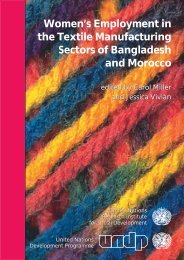Environmental Degradation and Social Integration - United Nations ...
Environmental Degradation and Social Integration - United Nations ...
Environmental Degradation and Social Integration - United Nations ...
Create successful ePaper yourself
Turn your PDF publications into a flip-book with our unique Google optimized e-Paper software.
The research documenting the sustainability, efficiency <strong>and</strong> adaptability of local systems of<br />
resource management in a wide variety of locales has generated interest in the possibility of<br />
reviving such systems where they have been displaced. In a limited number of cases, such a revival<br />
seems to be a possibility. However, the capacity <strong>and</strong> flexibility of traditional resource management<br />
systems have often been stretched to their limits, <strong>and</strong> they have become unable to h<strong>and</strong>le<br />
successfully the environmental challenges with which they are now faced.<br />
In many cases, population pressure has been a crucial component of this transition. The increased<br />
needs of a growing population have meant that traditional resource management practices, where<br />
they have been maintained, now yield a declining level of resources per capita. However,<br />
population growth is only one of the elements putting pressure on the ability of traditional resource<br />
management schemes to continue to maintain societies as they have in the past (see box 3). The<br />
growth <strong>and</strong> spread of national <strong>and</strong> global markets <strong>and</strong> the resulting increasing dem<strong>and</strong> for traded<br />
commodities mean that traditional mechanisms discouraging overexploitation <strong>and</strong> accumulation are<br />
losing their force. Changes in tenure systems, <strong>and</strong> l<strong>and</strong> concentration in particular, have similarly<br />
disrupted previously sustainable local management practices. In addition, migration <strong>and</strong> cultural<br />
homogenization mean that traditional management systems, <strong>and</strong> the social norms necessary to<br />
sustain them, are being forgotten. In other words, the processes described as “globalization” have<br />
had important environmental consequences at the local level.<br />
Influences on Local Level Resource Management<br />
It is thus important to look at the factors that influence people’s options for resource management<br />
on the local level. One of the most obvious limiting factors is poverty, <strong>and</strong> there is an observed<br />
correlation between environmental degradation <strong>and</strong> poverty in a wide variety of settings. This<br />
linkage has been exhaustively discussed, <strong>and</strong> the thinking on it has evolved similarly to that on<br />
local level resource management. After first blaming environmental degradation on the ignorance<br />
<strong>and</strong> wastefulness of the poor, conventional wisdom has turned to the explanation that the poor are<br />
forced to overexploit the environment by factors outside of their control.<br />
The simple version of this argument explains the linkage between poverty <strong>and</strong> environmental<br />
degradation in terms of two main processes. First, environmental degradation is said to cause<br />
poverty because, by definition, degradation involves the erosion of the resource base upon which<br />
the poor often depend for their livelihood, while the adverse impacts of environmental decline on<br />
people’s health further limits their productive potential. Second, poverty is said to cause<br />
environmental degradation because the poor are forced into marginal resource areas: they are<br />
driven out of the best agricultural l<strong>and</strong>s, for instance, <strong>and</strong> into fragile <strong>and</strong> unproductive ecosystems.<br />
In addition, the poor do not have sufficient security to invest in the maintenance activities necessary<br />
for long-term environmental health: their need for sufficient agricultural yields in the current<br />
season, for instance, means that they cannot afford to undertake soil conservation works, which are<br />
labour intensive <strong>and</strong> reduce short-term l<strong>and</strong> productivity. In short, it is argued that environmental<br />
conservation is a luxury that the poor cannot afford because their livelihood or even their<br />
immediate survival is at stake, <strong>and</strong> that the two processes together create a vicious circle, so that<br />
poverty <strong>and</strong> environmental degradation must be attacked simultaneously.<br />
Because of its emphasis on simultaneous poverty reduction <strong>and</strong> environmental rehabilitation, this<br />
argument has served to draw together people whose primary concern is environmental with those<br />
whose focus is on equitable development. It has been able to forge this coalition between the<br />
people-centred development lobby <strong>and</strong> environmentalists by asserting that the trade-offs between<br />
environmental rehabilitation <strong>and</strong> poverty alleviation are minimal: “an important conclusion of the<br />
links between environmental degradation <strong>and</strong> poverty is that there is no general conflict between
















